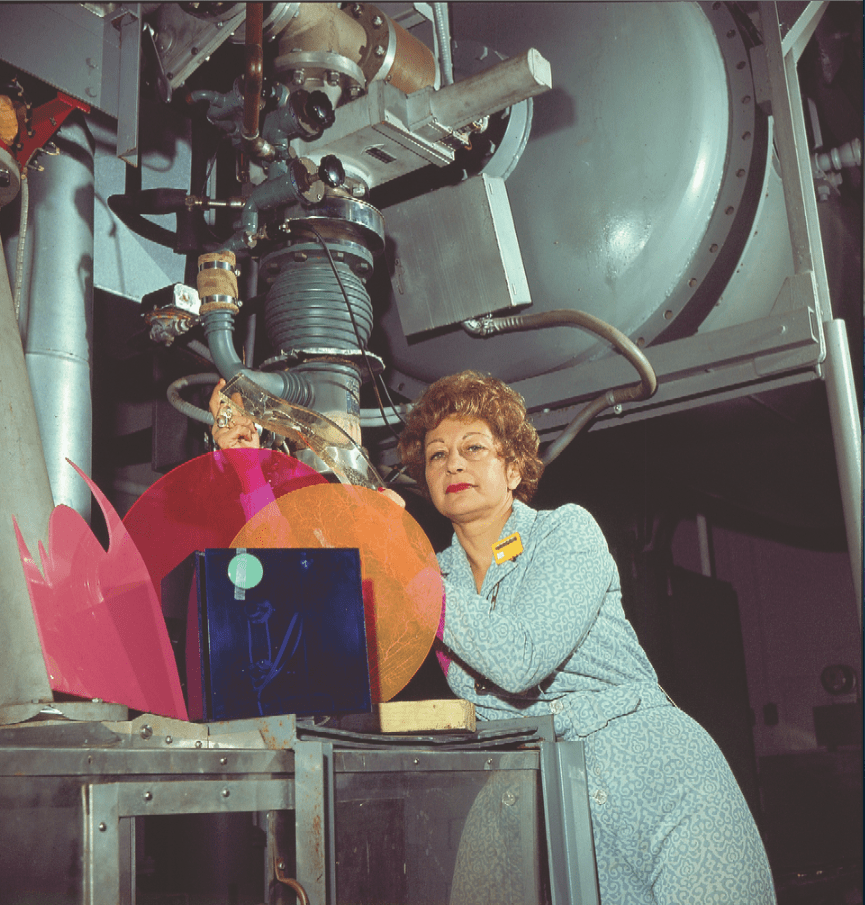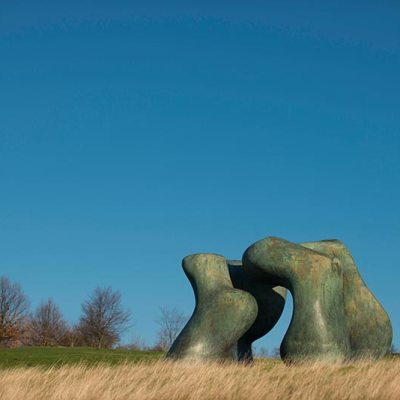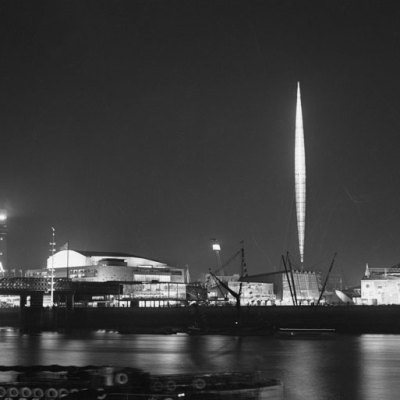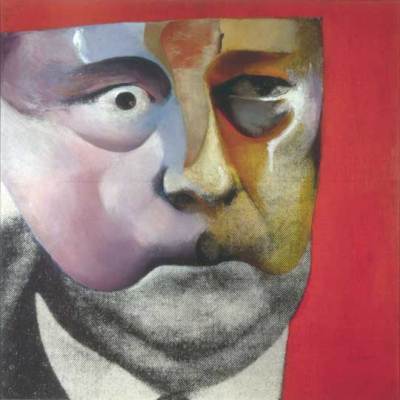The bronze plume of Henry Moore’s Nuclear Energy (1964–66) stands a mile to the west of Lake Michigan, atomic vapour frozen solid in the shore wind. It occupies a bare plaza in the middle of the University of Chicago, surrounded by residential halls and faculty buildings. ‘Occupies’ is the right word: Moore’s monument has an implosive density that the camera rarely captures. It seems somehow smaller than its 12 feet, thick and potent as a fissile core, as if the molten metal has condensed in the foundry, enriched itself, taken on mass. The effect is as much psychological as physical; the sculpture radiates into civic space. In the field of its gravity, the vast oval canopy of Helmut Jahn’s Mansueto Library resembles a piece of emergency architecture, the shield-dome from some meltdown long forgotten or hushed up.
One feat of metal commemorates another. Moore’s sculpture, completed 50 years ago this year, marks the place where the nuclear age dawned, the site of the converted squash court where, with a 25-foot stack of uranium and graphite, Enrico Fermi’s team successfully engineered the first self-sustaining chain reaction in November 1942. Fermi’s reactor was integral to the Manhattan Project, its success a crucial step in the production of plutonium for the first nuclear weapons. Without the chain reaction, no Hiroshima; without the political desire for an atomic bomb, no nuclear energy.
Part totem, part cloud, part skull, Nuclear Energy embodies that history of co-development. At the top, the bulbous explosive head; below, the smooth dome shelters a cavern scarred like bare rock. Imagine the whole massive structure inverted, falling from the belly of a long-range bomber, supporting pillars as stabilising fins. Now, instead of a dome, you have a warhead. Moore’s initial, more ambiguous, title – Atom Piece – was changed in order to emphasise the positive applications of nuclear technology and, according to some accounts, because of the unintended pun on ‘peace’. But why not embrace that plenitude of meaning? Moore’s sculpture bears it, built as it is out of the conviction that the destructive and the creative potentials of atomic science are unthinkable in isolation.
Throughout the 1950s, governments on either side of the Atlantic invested heavily in both aspects of nuclear technology, civilian as well as military, setting in motion sophisticated public relations exercises in order to sell the atomic age to the masses. Great Britain was first to get its programme of civil nuclear power up and running. At the Festival of Britain in 1951, Laurence Scarfe’s mural Atomic Energy depicted the shining new facilities that were about to bring the benefits of the atom into British homes; five years later, Calder Hall in Cumbria began producing both electric power for the national grid and weapons-grade plutonium for British nuclear tests. In the interim, Britain had joined America and the Soviet Union in equipping itself with an atomic bomb. But it was not long before the wider risks of nuclear technology became evident. Even as Peter Peri’s triumphant Atom Boy was being installed on the exterior wall of Longslade Grammar School in 1960, its utopian expression of nuclear humanism – of humanity soaring on the harnessed power of atomic energy – had already been undermined by the Windscale fire of the autumn 1957. Windscale was a plutonium production facility for the British atomic weapons project rather than an electricity-generating reactor, but its proximity to the newly commissioned Calder Hall, combined with the severity of the accident, ensured that nuclear terror no longer simply meant fear of nuclear warfare.
To many, the spectre of nuclear weaponry seemed to impoverish the visual imagination, to obliterate meaning. The invisible agency of radiation marked a challenge to the power of the image that the artists of the image had struggled to overcome. Andy Warhol’s silkscreen Atomic Bomb (1965) makes the necessary point, its crimson repetitions of a mushroom-cloud image following the gruelling arms-race logic of deterrence to a terminal frame of stygian darkness. Vision dissolves in the A-bomb’s searing radiance.
Sculptors, on the other hand, found powerful new ways to respond to this assault on the domain of the visible. Plenty has been written about innovations in British sculpture in the years following the Second World War, which culminated in the landmark exhibition, ‘New Aspects of British Sculpture’, at the 1952 Venice Biennale. Herbert Read’s ponderous coinage – ‘the geometry of fear’ – gave a name and an identity to a disparate group of sculptors whose work stole the show, including Reg Butler, Lynn Chadwick, and Kenneth Armitage. But it’s difficult to see, in the tense distortions of those works of the early 1950s, anything that responds specifically to nuclear terror. For that, one has to look to a slightly later moment. In the calcinated distortions of Elisabeth Frink’s Harbinger Bird sculptures of the early ’60s, for instance, one begins to see a new kind of form, in which volumes and surface textures seem shaped directly by the unseen forces described in the civil defence films of the period – ‘heat’, ‘blast’, and ‘fallout’.
In a work contemporary with Moore’s Nuclear Energy, the astonishing Beach Girl Nuclear Victim (1966), Colin Self eschews ambivalence in favour of a direct assault on the senses. The first thing you notice about Self’s harrowing sculpture – a confection of cinders, paint, and a shop-window mannequin – is the textural contrast between the bloated, granular cast in which most of the anatomy is sheathed and the smooth sheen of those body parts that have somehow escaped disfigurement: the well-shaped nose and cheek, the exposed curve of breast, the poised left hand. The total impression is overwhelmingly of decay and morbidity, an eroded, abraded surface that resembles marble or bronze statuary long submerged, or the burnished flesh of some mummified dignitary. Yet the heaviness of that dark matter contrasts with the strange weightlessness of the figure’s pose. To me it recalls, absurdly, Giambologna’s Mercury, which floats on the breath of a cherub where Self’s nuclear victim has been scarred by the toxic gale of an atomic detonation. The left foot extends downwards; the right leg bends slightly back before its abrupt amputation; the remaining fingers gracefully pinch, not in extremity, but rather as if gently holding some delicate trinket.
That pristine hand is, I think, the key to a sculpture that demands to be grasped: to be grasped, that is, quite literally; to be approached in accordance with its own tactility. If the mannequin under all this paint and ash began its existence inviting the shallow gaze of the window-shopper, its new coating of abject matter fosters the desire to fondle – to see, as it were, feelingly. We want to know how that charred imitation flesh feels, how the illusion might be supported or broken by contact.
What Self’s atomic sculpture shares with Moore’s, despite the obvious differences in style, is an emphasis on texture and touch, on surface variations that demand a tactile rather than a merely optical way of seeing. At the same time, both sculptures repel that imagined tactility: Nuclear Energy by its sheer monumental mass, Beach Girl Nuclear Victim by its uncanny, hyperreal ugliness. The desire for physical contact comes to be felt as somehow menacing, dangerous even, as if these objects have themselves been rendered radioactive, emanating an invisible, lethal energy. Their power comes not, first of all, from what they represent, whether in abstraction or in hyperreal figuration, but from the way each in its own way activates the viewer’s physical response to a dimly understood phenomenon – radiation – whose effects bypass altogether the realm of aesthetic experience, the evidence of the senses. These sculptures aestheticise nuclear energy in the proper sense of the word: not by making it beautiful; but by engineering a sensory equivalent for what is otherwise inapprehensible. For Self, that equivalent finds expression in the mode of the grotesque; for Moore, it is a figure of the sublime.
Even while Moore and Self were constructing their divergent responses to the atomic age, other artists were beginning to investigate the artistic potential not of symbols or vague anxieties, but of the techniques and technologies of nuclear science itself. Throughout the 1960s the American painter and sculptor Alyce Simon conducted experiments with high-voltage particle accelerators at the laboratories of Radiation Dynamics. By irradiating various materials – most commonly, blocks of clear acrylic – Simon developed a method by which the molecular structure of the materials could be broken down by radiation into fine capillary patterns. Her work includes startling lightbox arrangements, resembling alien stars in deep space, as well as oval and cuboid forms shot through with lightning-bolts of fossilised energy.
These transparent forms record the fractal tracks of electrons as they pass through a material substrate. To Simon, they came to represent a taming of subatomic contingencies in which ‘chance and intention became inseparable’. But her works – which included irradiated pendants and bracelets as well as sculptural works – also helped to domesticate the destructive potential of the controversial technologies they deployed. In turning the methods of subatomic physics into techniques for the decorative arts, Simon endeared herself to the official institutions involved in shaping the cultural reception of nuclear technologies. Two years after a first solo exhibition organised by the Smithsonian in 1969, she travelled to Geneva, becoming the first artist to participate in the United Nations International Conference on the Peaceful Uses of Atomic Energy.
Alyce Simon (1925–2011) with particle accelarator at Radiation Dynamics, Inc. NY, 1975 © Tree of Life, Inc.

Still, we can think of Simon’s nuclear experimentation as the beginning of a shift in emphasis away from art that sought merely to reproduce nuclear iconographies, and towards a set of new approaches that emerged as artists began to integrate the technologies and the materials of the nuclear age into the fabric of their own work. Most radically, the maverick sculptor James Acord – who once held the US Nuclear Regulatory Commission’s only private licence for working with radioactive materials – spent much of his career seeking permission to work directly with nuclear-reactor technology. When this was not forthcoming, he claimed to have developed his own method of ‘transmuting’ the uranium from the glaze on pre-war Fiestaware ceramics into plutonium by using radioactive Americium scavenged from domestic smoke detectors. For Acord, such reactions, in which atoms of one element decay to form atoms of a different, more stable substance, promised to realise the ancient dream of the alchemists. With projected works such as his Transmuted Test Foils Reliquary he sought to solve the problem of nuclear unrepresentability not by showing the trace of electrons or producing the illusion of nuclear aftermath, but by fundamentally reshaping the elemental structure of materials drawn from the nuclear industry.
In a talk given in Ireland in 2010, the year before his death, Accord drew an explicit parallel between his own activities as an artist and those of nuclear scientists. ‘Nuclear process works on geometry. The ordered arrangement of nuclear materials in space and void is what makes nuclear reactors and nuclear weapons work; and the ordered arrangement of mass and void is what makes the art of sculpture work.’ By working on a double scale – by attempting to shape the atomic structure of materials through radioactive ‘transmutation’ as well as by producing reliquaries and monstrances for the preservation of those materials – Acord’s ambitious project took nuclear-era sculpture in an entirely new direction.
It’s easy to see Acord as a kind of nuclear Quixote, chasing a fantasy of nuclear alchemy, but his efforts display both the fascination of an autodidact engineer and the devotion of a reverent acolyte. His sculptures – many more of them designed than executed – suggest the sacred art of some nuclear-age sect, willing the god to become manifest in and through the process of transubstantiation. Ultimately, Acord wanted to eliminate the gap between the representation of nuclear material and its embodied presence, knowing all the while that radioactive substance, like divine presence, remained lethally inapproachable. This is perhaps why so many of his works remain fascinatingly incomplete – even an apparently finished piece such as the monitory Monstrance for a Grey Horse lacks the radioactive component that was originally to have been included.
In the aftermath of the Fukushima disaster of 2011 – by some distance the most severe nuclear accident since Chernobyl in 1986 – the physiological, psychological, and ecological effects of nuclear power have again proven compelling to artists who, like Acord, have sought to imbue their work with the authenticity of irradiated matter. Hilda Hellström’s The Materiality of a Natural Disaster (2012), for instance, consists of a set of rough dishes moulded from soil collected in the rice-fields surrounding the sealed-off power plant. Because of the radioactive component of the soil, the resulting vessels are rendered unsuitable for the functions suggested by their forms: radioactive toxicity becomes the measure of their aesthetic purity.
Indeed, Fukushima has become a reference point for a set of connected contemporary anxieties, ecological and economic as well as nuclear. Exhibitions such as last year’s ‘The Radiants’, at Bortolami Gallery in New York, and projects like Arts Catalyst’s Nuclear Culture have shown how visualisations of nuclear power and its associated risks have emerged from a tradition stretching back to the contact prints executed by Henri Bécquerel and Marie Curie. Meanwhile, the Fukushima exclusion zone has itself become the unlikely site of an exhibition organised by the Japanese art collective Chim↑Pom, ‘Don’t Follow The Wind’. Details of the artworks themselves are appropriately difficult to come by, though among them is Trevor Paglen’s Trinity Cube (2015), a 20cm3 block of irradiated glass from Fukushima combined with a core of Trinitite, the eerie man-made mineral produced from fused sand at the site of the first nuclear weapons tests. Installed within the abandoned zone, these works will remain off-limits until falling levels of radioactivity render the area safe for humans to return.
These works remind us that in world-historical terms, we live at the beginning of a nuclear age that already stretches tens of thousands of years into the future: a timescale well beyond the recorded experience of our species. Drowned undersea or buried deep in the earth, the waste products of our nuclear projects will still be toxic when our descendants, if we have any, bear no more resemblance to us than we to the Palaeolithic sculptor who made the Willendorf Venus. What will they think we wanted? What will they think we feared?
From the January issue of Apollo: preview and subscribe here.



